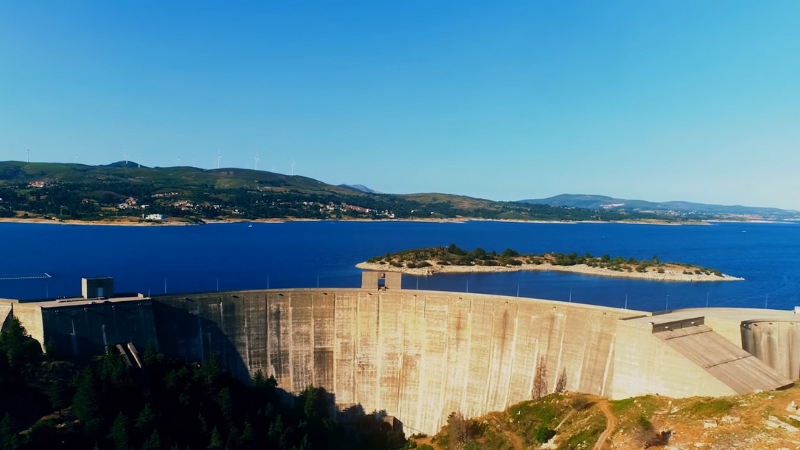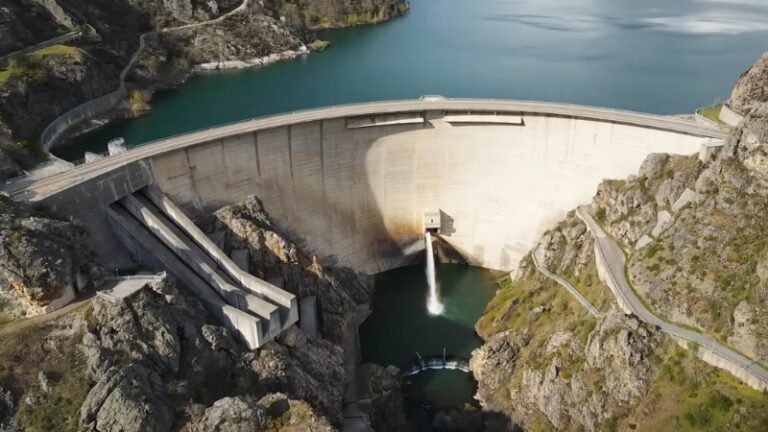Traditional dam construction has significant drawbacks. Reservoirs flood vast areas, destroying habitats and displacing wildlife, while blocking fish migration routes, like those for salmon, disrupting aquatic ecosystems.
A study notes dams have contributed to an 84% average decline in freshwater wildlife since 1970.
Sediment trapping behind dams leads to downstream erosion, affecting river deltas, and reservoirs can emit greenhouse gases like methane from decomposing organic matter.
Socially, dams have displaced 40-80 million people globally, often without adequate compensation, causing economic and cultural disruptions.
Key Takeaways
Benefits and Environmental Concerns
Dams are pivotal in producing renewable energy. According to the International Hydropower Association, hydropower accounts for over 16% of global electricity production, making it the largest source of renewable energy.
Reservoirs created by dams store water for agricultural irrigation, drinking supplies, and industrial use, supporting livelihoods and economies, particularly in arid regions.
By regulating river flow, dams can mitigate the severity of floods, protecting downstream communities and ecosystems according to Cybrary.
However, the environmental implications of dam construction and operation are profound:
- Disruption of Sediment Transport: Dams trap sediments that would naturally replenish downstream ecosystems and deltas. Research indicates that more than a quarter of Earth’s land-to-ocean sediment flux is retained by dams, leading to sediment starvation downstream, which can cause riverbed erosion and loss of fertile deltas.
- Greenhouse Gas Emissions: Reservoirs can emit greenhouse gases (GHGs), particularly methane, due to the decomposition of submerged organic matter. A study published by the American Geophysical Union found that GHG emissions from reservoirs are approximately 29% higher per area than previously estimated.
- Impediment to Fish Migration: Dams obstruct migratory routes for fish species, leading to population declines. In the United States, over 2 million dams and barriers hinder fish migration, contributing to the decline of many fish populations.
- Alteration of Natural Habitats: The creation of reservoirs floods existing terrestrial ecosystems, displacing wildlife and human communities, and altering local biodiversity.
Sediment Trapping: Implications and Mitigation
Sediment transport is vital for maintaining river ecosystems, fertile floodplains, and deltas. Dams disrupt this natural process by trapping sediments, leading to several issues, according to a study from Science.org:
- Reservoir Sedimentation: Accumulated sediments reduce the storage capacity of reservoirs, diminishing their effectiveness over time.
- Downstream Erosion: Sediment-starved water released from dams can erode riverbeds and banks downstream, destabilizing ecosystems and infrastructure.Waterkeepers Iraq
- Coastal Degradation: Reduced sediment flow to deltas and coastal areas can lead to land loss and increased vulnerability to sea-level rise.
A study on sediment trapping efficiency highlights that large reservoirs can trap approximately 26% of global sediment flux, underscoring the scale of this issue, according to ScienceDirect.
Mitigation Strategies
- Sediment Management Techniques: Implementing strategies such as sediment bypassing, sluicing, and dredging can help maintain sediment flow downstream.
- Design Modifications: Constructing dams with sediment release mechanisms or designing run-of-river dams that allow sediments to pass through can reduce sediment trapping.
- Adaptive Reservoir Operation: Adjusting water release schedules to mimic natural flow variations can facilitate sediment transport.
Greenhouse Gas Emissions from Reservoirs

While hydroelectric dams are often celebrated for providing a renewable source of energy, the environmental narrative becomes more complex when we consider the greenhouse gas (GHG) emissions from their associated reservoirs.
Contrary to the popular belief that hydropower is entirely “clean,” scientific research over the last two decades has highlighted that reservoirs—particularly in tropical regions—can be significant sources of GHGs such as methane (CH₄), carbon dioxide (CO₂), and nitrous oxide (N₂O).
These emissions primarily arise from the decomposition of organic material submerged during the reservoir’s formation. As plant matter and soil break down anaerobically (without oxygen), methane—a greenhouse gas with a global warming potential over 25 times that of CO₂ over 100 years—is released.
Carbon dioxide is also emitted through aerobic decomposition and respiration from aquatic organisms. In tropical climates where organic productivity is high, this process is especially pronounced due to elevated temperatures and abundant vegetation before flooding.
A landmark study published in Nature Geoscience by Deemer et al. (2016) synthesized data from more than 250 reservoirs globally and estimated that reservoir-based emissions contribute approximately 1.3% of all anthropogenic greenhouse gas emissions worldwide. This is a significant figure, placing reservoirs on par with emissions from aviation and agriculture in some cases.
Furthermore, a more recent global assessment by UNESCO’s International Hydrological Programme suggests that reservoirs currently emit an estimated 0.88 gigatonnes of CO₂-equivalent annually, with methane accounting for roughly 80% of that total.
These emissions are not uniformly distributed—tropical reservoirs such as those in Brazil’s Amazon basin, where large tracts of forest are flooded during dam construction, are the most intense emitters per square meter.
Case Studies Highlighting Responsible Practices in Dam Development and Management
The Three Gorges Dam, China
View this post on Instagram
The Three Gorges Dam, completed in 2012, is the world’s largest hydroelectric power station by installed capacity (22.5 GW). Situated on the Yangtze River, the project has delivered enormous benefits in terms of flood control, renewable energy, and inland navigation.
However, it has also been the subject of substantial criticism regarding environmental degradation and human displacement.
Despite these concerns, the Chinese government has implemented several mitigation strategies to address ecological and hydrological issues, according to Research Gate. One key effort involves sediment management.
Because the Yangtze River naturally carries high sediment loads, engineers incorporated sediment flushing mechanisms within the dam design to periodically release accumulated sediment downstream, helping to reduce erosion and maintain delta stability.
In addition, to address the disruption of aquatic life, particularly the extinction risk facing species like the Chinese paddlefish and Yangtze sturgeon, fish hatchery and breeding programs were launched. While these have had mixed results, they represent a growing awareness of the ecological impacts of damming and a move toward more adaptive, scientifically informed management.
Efforts to reduce greenhouse gas emissions from the massive reservoir have also been introduced, including monitoring of methane levels and management of water levels to minimize anaerobic decomposition of organic matter. However, studies still highlight the need for more robust, long-term ecological monitoring.
The Three Gorges Dam remains a complex example—one that demonstrates both the immense potential and the substantial challenges of large-scale dam projects. Importantly, it has pushed China to evolve its policies on dam planning and to incorporate environmental safeguards into future hydropower projects, especially those in sensitive ecological zones.
The Elwha River Dam Removal, USA
It’s hard to predict exactly how a river will heal after a dam removal. The Elwha River dam removal is a beautiful example of how quickly a river can start to heal itself when its natural flow is restored. https://t.co/UgoDZwFFrR
— American Rivers (@americanrivers) March 26, 2024
In stark contrast to the Three Gorges Dam, the Elwha River Restoration Project in Washington State, USA, is a landmark example of reversing the impacts of outdated and environmentally harmful dams.
The Elwha and Glines Canyon Dams, built in the early 20th century without fish ladders, blocked more than 70 miles of upstream salmon habitat. This resulted in the decimation of native fish populations, including Chinook salmon and steelhead trout.
Over the 20th century, the ecosystem surrounding the Elwha River degraded significantly, and sediment flow to the river mouth was nearly halted, impacting coastal ecosystems.
In a bold decision driven by tribal advocacy (especially from the Lower Elwha Klallam Tribe), scientists, and environmentalists, the U.S. government initiated a full dam removal project—the largest of its kind in history. Completed between 2011 and 2014, this $327 million effort aimed to restore natural river functions according to NOAA Fisheries.
The results were both rapid and profound. Within just a few years:
The Elwha case demonstrates that with careful ecological planning and community engagement, even large-scale ecological damage can be reversed. It serves as a blueprint for future dam removal projects, especially in locations where energy or flood control benefits are outweighed by ecological costs.
Statistical Overview
To understand the broader implications of dam construction and operation, it’s useful to examine key impact areas supported by global data:
Impact Area
Statistic
Sediment Trapping
Large dams globally trap approximately 20%–30% of the annual sediment flux.
GHG Emissions
Global reservoir carbon emissions peaked at 4.4 TmolC/year in 1987, declining due to decreased carbon burial. Methane remains a dominant concern.
Fish Migration Barriers
Over 2 million dams and barriers in the U.S. alone impede fish migration, leading to severe population declines.
Displacement by Dams
An estimated 40–80 million people have been displaced globally by dam construction projects.
Biodiversity Impact
Dam-related freshwater habitat alteration is linked to an 84% decline in monitored freshwater wildlife populations since 1970.
Energy Contribution
Hydropower contributes to about 16% of global electricity and over 60% of renewable generation.
The Bottom Line
@nunchakusdragon How do they build dams? #dam #water #engineering #construction #fyp #foryou #foryoupage ♬ original sound – Nunchakusdragon
Dams, without question, are powerful tools—they’ve helped societies manage water, generate renewable energy, and protect against floods. But that power comes with a heavy footprint.
The numbers don’t lie: sediment starvation, biodiversity collapse, methane emissions, and millions displaced. These aren’t fringe cases—they’re systemic consequences of how dams have been traditionally built and operated.
What’s encouraging is that it doesn’t have to be this way. The Elwha River restoration proves that recovery is possible, while the Three Gorges Dam—despite its flaws—shows that nations can evolve their approach when pressed by science, public concern, and environmental consequences.
In my honest opinion, the future of dam construction must shift from brute-force infrastructure to ecologically intelligent engineering. We’re no longer in an era where development at all costs is acceptable. With the climate crisis, vanishing ecosystems, and pressure on freshwater resources, the way forward isn’t to stop building—it’s to build better.
References
- Mongabay – The world’s dams doing major harm — but a manageable problem
- British Dams Society – People and Environment
- Cybrary (Friends of Merrymeeting Bay) – Dams and Fish Migration
- American Geophysical Union (AGU) – Greenhouse gas emissions from reservoirs higher than previously expected
- NOAA Fisheries – Barriers to Fish Migration
- Science.org – Mapping the world’s free-flowing rivers
- ScienceDirect – Sediment trapping efficiency of reservoirs
- Nature Geoscience – Greenhouse gas emissions from reservoirs: A global synthesis
- UNEP / UNESCO – Emissions Gap Report 2023
- ResearchGate – Managing the Three Gorges Dam to Implement Environmental Flows in the Yangtze River
- NOAA Fisheries – Elwha River Restoration: A Case Study in Adaptive Management

